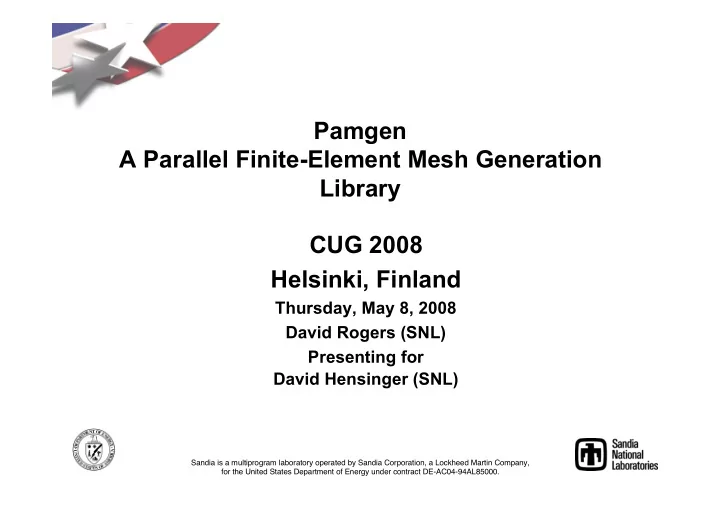

Pamgen A Parallel Finite-Element Mesh Generation Library CUG 2008 Helsinki, Finland Thursday, May 8, 2008 David Rogers (SNL) Presenting for David Hensinger (SNL) Sandia is a multiprogram laboratory operated by Sandia Corporation, a Lockheed Martin Company, for the United States Department of Energy under contract DE-AC04-94AL85000.
Parallel Mesh Generation Library Driver & Challenges • Analysis codes and capability • Scale well: multiple machines are leaving pre- thousands of processors and processing tools and shared billion + elements memory machines behind – Exploit determinism • Serial mesh generation – Eschew communication strategies were unable to • Ease of Use: run different supply analysts’ demands decompositions without for: modifying input deck – Billions of Elements – Automatic load balancing – Quick Turn-around – Consistent topology/geometry Purple, 1532 nodes R.S. 12960 Nodes
Enabling/Limiting Assumptions • All Processor Have Identical Information – No need to communicate • All Processors are Identical (except for Ids) – Calculations produce identical results – No need to communicate • Communication is Unavailable – Resist the temptation – Scale really well • All Meshes Will Consist of One or More Structured Blocks – Connectivities easily calculated – Geometries derive from topologies
Execution Stages • Information Distribution – Each processor gets a complete description of the mesh. • Decomposition, run equivalently on each processor such that each processor: • Receives a list of its local elements • Can calculate the processor of any element • “Serial” Information Generation – Nodes, Elements, Connectivity local to a processor • “Parallel” Information Generation – Inter-processor communication information. • Geometric Transformations – User provided subroutines to calculate new nodal coordinates
Library Interface • Create a “mesh” within the library int Create_Pamgen_Mesh(char * mesh_description, int dimension, int rank, int num_procs); • Query the library to build up representation in client code – the same as may be done with a file interface API Im_ex_get_info(…) Im_ex_get_connectivit(…) • After queries are completed the library memory can be cleared with a delete function.
Capabilities • Topologies – Cubes – Solid Cylinders – Full and partial – Hollow Cylinders – Full and partial • Geometries – Those suggested above plus projection to sphere – Arbitrary user-specified geometry transformation • Boundary conditions – Call out nodes and element faces on topological faces,edges,corners • Decompositions – Optimal bisection – User controlled – Sequential – Random
Example A Brick mesh mesh brick numz 2 zblock 1 2. interval 5 zblock 2 8. interval 4 numx 2 xblock 1 5.0 interval 5 xblock 2 5.0 interval 5 numy 2 yblock 1 10. first size 1. last size .1 yblock 2 10. first size .1 last size 1. end end
Example A Partial Cylinder with Node Sets and Side Sets mesh radial trisection trisection blocks, 2 zmin -0.00075 numz 1 zblock 1 1. interval 4 numr 3 rblock 1 2.0 interval 4 rblock 2 3.0 interval 4 rblock 3 4.0 interval 4 numa 1 ablock 1 90. interval 12 end set assign nodeset, ilo, 100 block sideset, ilo, 35, 2 block sideset, ihi, 45, 2 end end
Example A Brick With Random Decomposition for 2 Processors mesh brick numz 1 zblock 1 2.0 interval 15 numx 1 xblock 1 2.0 interval 15 numy 1 yblock 1 2.0 interval 15 end decomposition stratgy random end end
Example A Portion of a Solid Cylinder mesh radial trisection trisection blocks, 2 zmin -0.00075 numz 1 zblock 1 1. interval 4 numr 3 rblock 1 2.0 interval 4 rblock 2 3.0 interval 4 rblock 3 4.0 interval 4 numa 1 ablock 1 90. interval 12 end end
Example A 2D Block of Mesh with Geometry Transformation mesh rectilinear nx = 10 ny = 10 bx = 3 by = 3 gmin = -1.0 -1.0 gmax = 1.0 1.0 end user defined geometry transformation " double r = sqrt(inxcoord*inxcoord +inycoord*inycoord); double theta = atan2(inycoord,inxcoord); if(r > 0.5) { theta = theta + (3.14159 / 4.0)*((r- 0.5)/0.5); outxcoord = r*cos(theta); outycoord = r*sin(theta); } " end end
Example A 3D Solid Cylinder Decomposed for Eight Processors mesh radial trisection trisection blocks, 4 numz 1 zblock 1 4.0 interval 1 numr 3 rblock 1 2. interval 4 rblock 2 3. interval 4 rblock 3 5. interval 4 numa 1 ablock 1 360. interval 32 end decomposition strategy numprocs j, 8 end end
Availability and Distribution • Available under GNU Lesser General Public License (LGPL). • Distributed as a component of Trilinos • Documented in report: SAND 2008-1933 http://trilinos.sandia.gov/packages/pamgen
Recommend
More recommend